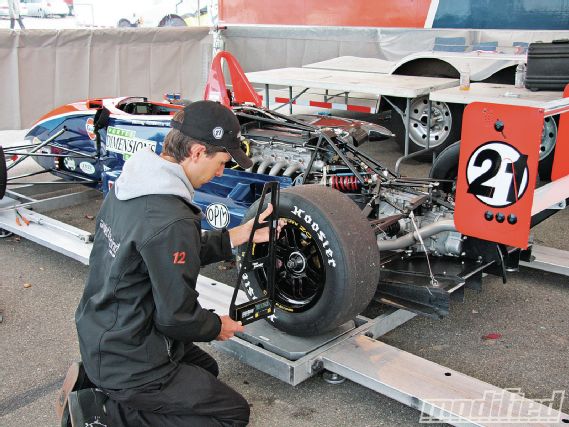 | Tuning For The Track - Suspension Tuning - Tech
| Tuning For The Track - Suspension Tuning - Tech
So you’ve completed the basics: a set of dedicated track wheels and tires, along with some track-capable brake pads and high-temp brake fluid. You’ve been lapping, honing your craft and have probably completed a track day with coaching or even a racing school. What’s next? How do you get the most from your car and continue to lower your lap times, aside from more seat time and coaching?
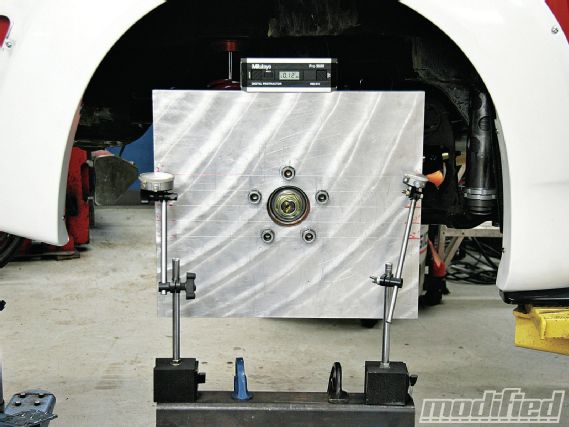 |
Tuning For The Track - Suspension Tuning - Tech
|
Tuning For The Track - Suspension Tuning - Tech
The answer is from your suspension. Tuning your vehicle’s handling can yield the greatest lap-time improvements per dollar of any modification, as well as making the whole experience more enjoyable. I’m going to break down suspension tuning into a series of steps to get the most from your vehicle.
First off, you’ll need some tools to help evaluate your changes and ensure repeatability. Invest in a nice tire-pressure gauge, tire pyrometer and toe plates with two matching tape measurers, and a data system of some sort that gives you lap times. If it’s in the budget, a digital camber gauge is worthwhile. Be sure to start a binder with setup notes so you can keep track of changes made and what works — this is a must-have. Armed with your tools, you’ll either need a flat surface at the track or borrow someone’s setup pad to take all your measurements on.
But before you even head to the track, if there’s one thing you can do, it’s a high-performance alignment at a reputable shop. Alignment settings are so crucial that I check all of the pro race cars I set up before every session. You’d be surprised how far components can move after minor contact or dropping wheels in the dirt. This is where your toe plates can be used to make sure your toe remains the same. (Using a paint pen to match-mark your eccentric bolts prior to your alignment can be a quick way to identify what has changed after a session.) You’re going to want to do some research on your particular vehicle to see what’s needed to hit at least 3 degrees of camber front and rear. Each tire is unique and will need some time spent with the pyrometer to find its optimum camber settings, but I’ve yet to work with a tire/suspension combination of any type that isn’t working well at 3 degrees negative.
Refer to the chart for my recommendations — don’t be afraid to experiment, as these are just guidelines. Different driver abilities will require slight variations. Be warned if you’re using OEM-type rubber bushings that have considerable flex — you should keep your rear toe settings conservative, or the car may experience excessive oversteer. Rough/dusty track surfaces with low grip will work better at the low end of the camber adjustment range, whereas clean, smooth, sticky surfaces will work better at the higher end.
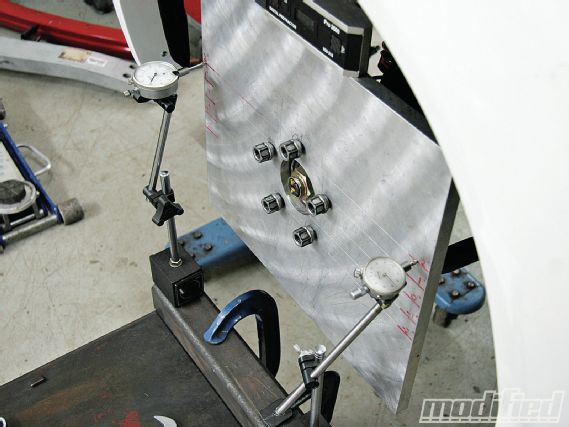 |
Our bumpsteer jig is nothing more than a flat plate drilled to 5x14.3 inches and a pair of dial indicators. Recording the dial indicator readings at 1-inch increments from -2-inch to +2-inch wheel travel allows for precise measurement of toe change in ride (or bumpsteer).
|
Our bumpsteer jig is nothing more than a flat plate drilled to 5x14.3 inches and a pair of dial indicators. Recording the dial indicator readings at 1-inch increments from -2-inch to +2-inch wheel travel allows for precise measurement of toe change in ride (or bumpsteer).
While your stock springs/dampers are perfectly adequate to get around the track, they’re most certainly not designed for the task. To achieve the ride-comfort targets set by the manufacturer, road-going cars are always sprung and damped too soft for serious track use. Lowering springs will serve to lower your car’s center of gravity, which will increase cornering grip and provide increased spring rates, minimizing pitch and roll to improve the car’s response and help maintain your target alignment settings.
Recommended Track Alignment Settings
DrivetrainFront Toe Total, Rear Toe TotalFront CamberRear CamberFront Caster
FWD0 to -0.375" + .125 to -0.25"-2.5 to -3.5 degrees-3.0 to -4.5 degreesMax
RWD0 to -0.25" + 0.25" to 0-3.0 to -4.0 degrees-2.5 to -3.5 degreesMax
AWD0 to -0.375" + .125 to -.125"-3 to -3.5 degrees-2.5 to -3.5 degreesMax
These are all good things, but what must be considered is that the spring/damper are designed to work as a system. Increasing the spring rate without adjusting the dampers’ valving to match will always result in a bouncy ride and premature damper failure. All of the positives will be quickly overridden by the loss of grip and control caused by the dampers’ inability to control wheel travel. The solution is to opt for a matched spring/shock combination or for an adjustable coilover that will give you the necessary damping adjustment range to run an array of spring rates. I can’t emphasize enough that this isn’t the place to cut corners. Brands like Moton, Anze, AST, Motion Control, KW and Öhlins provide a range of track/race-specific dampers that offer excellent handling characteristics while maintaining good ride quality. They’re able to manage stiff spring rates that help provide quick transient response yet maintain composure over the bumps and curbs.
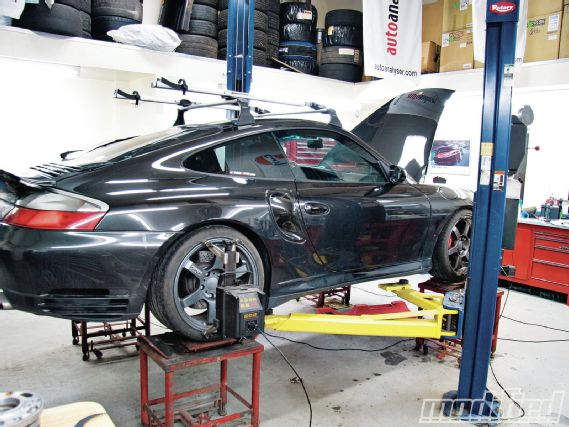 |
Tuning For The Track - Suspension Tuning - Tech
|
Tuning For The Track - Suspension Tuning - Tech
Learning to adjust your dampers is the next step. The first step is to understand what the adjustments are actually doing. Compression adjustment controls the force exerted relative to the damper’s shaft speed when it’s compressed (up stroke when encountering a bump), while rebound adjustment controls the force exerted relative to the damper’s shaft speed during extension. This can be further broken down into low- and high-speed adjustments, where low speed is typically shaft speeds less than 1–1.5 inches per second and high speed is anything over that. Pitch and roll are in the low-speed range, while surface roughness, curbing and so on will fall in the high-speed range. Independent adjustment of the low- and high-speed ranges greatly simplifies your task when achieving the ideal setup.
High-speed adjustments are the most difficult to get right, so start there. Get the car up to temperature, adjust your tire pressures and then do three laps with high-speed compression and rebound at full soft. Continue adding compression and repeating until your lap times peak, then begin to fall. You should feel the car becoming harsh and losing grip over the bumps — return to the setting that corresponded with your best lap time. Next, perform the same adjustment sweep for rebound. If you have low-speed control, begin to add low-speed compression and repeat.
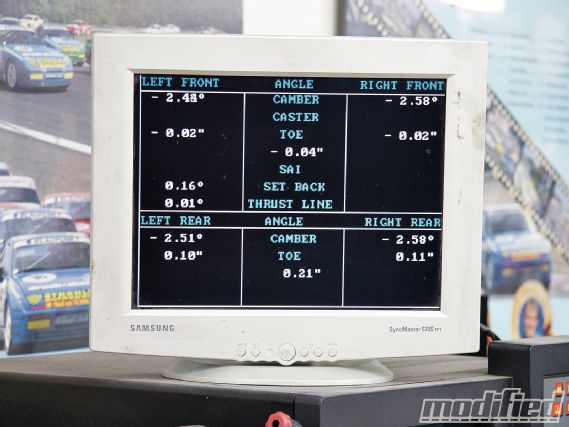 |
After installing a set of KW V3s and adjustable GT3 front control arms on our 996TT, a full alignment was in order. The laser-leveled stands and calibrated alignment machine ensure the settings are spot on. It’s set up primarily for street use on street tires.
|
After installing a set of KW V3s and adjustable GT3 front control arms on our 996TT, a full alignment was in order. The laser-leveled stands and calibrated alignment machine ensure the settings are spot on. It’s set up primarily for street use on street tires.
Following the adjustment sweeps, you’ll have a reasonable baseline to work with. Changing conditions will require you to adjust your settings, particularly for wet weather, where reducing compression and rebound will increase grip and make the car more predictable to drive. You can also use your low-speed compression and rebound adjustments to fine-tune the car’s over/understeer balance at corner entry and corner exit. Mid-corner will remain mostly unaffected, as the dampers control transient response as opposed to steady-state cornering. Increasing spring rates will require an increase in high-speed rebound damping, while a reduction will require less.
Anti-rollbars serve as an excellent means to adjust the vehicle’s mid-corner over/understeer balance. With adequate spring rates for your vehicle’s weight/downforce, you can expect increasing roll stiffness at one end of the vehicle to increase that end’s share of the load transfer during cornering, resulting in less grip at that end and more at the other. Total load transfer hasn’t changed, just the distribution of it from front to rear. This is how adjustable anti-rollbars can be used to fine-tune the handling balance and are a huge asset. Tire wear and fuel consumption can cause handling balance to change — even within a session — which is why you’ll see most serious race cars fitted with a cockpit-adjustable anti-rollbar setup (where rules permit). If you find your car isn’t responding to your anti-rollbar adjustments, it’s possible your roll stiffness is greater than your chassis torsional stiffness; at that point, going stiffer won’t help. Also, if you’re a FWD/AWD guy and you’re already picking up the inside rear wheel during cornering, adding more rear roll stiffness won’t help reduce understeer. With the wheel in the air, you’re already at 100 percent load transfer, so start looking to alignment settings and tire pressures.
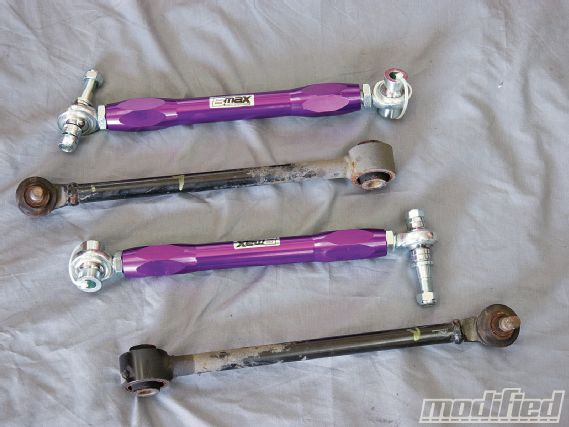 |
S2000 rear bumpsteer kit versus stock toe arms. You can see the inboard rod end replaces the OEM rubber bushing, thus removing compliance, and the outer pin allows for adjustment of the toe curve by adding/removing shims.
|
S2000 rear bumpsteer kit versus stock toe arms. You can see the inboard rod end replaces the OEM rubber bushing, thus removing compliance, and the outer pin allows for adjustment of the toe curve by adding/removing shims.
High durometer bushings for dual-duty street/track cars are a great way to improve your car’s precision and responsiveness. For dedicated track cars, spherical bearings can’t be beat; the car will be substantially more predictable, and you’ll be able to run more aggressive alignment settings. While these are often a labor-intensive job to install, once you drive a car on track with full spherical bearings, you’ll find it hard to go back to anything else. Be sure to use a high-grade spherical bearing like those in the Aurora Performance series that are designed for the task at hand. The cheaper low-grade spherical bearings will wear out prematurely, resulting in unpredictable alignment changes and lots of rattles.
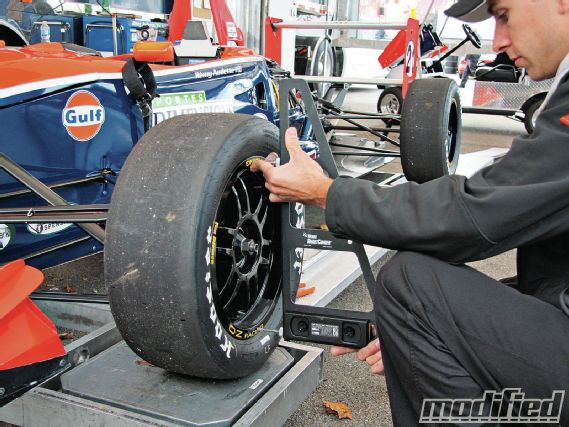 |
Alignment settings are critical. In this picture, I’m checking camber track-side on the setup pad on the ’11 F2000 overall championship-winning car before the final race at Watkins Glen.
|
Alignment settings are critical. In this picture, I’m checking camber track-side on the setup pad on the ’11 F2000 overall championship-winning car before the final race at Watkins Glen.
While searching for spherical bearing options and the pieces to reach your target alignment, you’ll find a plethora of roll-center adjusters and bumpsteer tuning kits that will make your car handle a lot better. With a clear understanding of what these kits can accomplish, it will be easier to decide what’s right for your application. Bumpsteer is nothing more than toe change relative to wheel travel, so zero bumpsteer refers to zero toe change over the suspension’s range of motion and is typically what I aim for because it makes for a very predictable-handling car.
When you order a bumpsteer kit, it will usually include tie-rod ends and rear toe links with shim stacks used to adjust the outboard height of the pickup point. By changing the vertical location of these points, it’s possible to alter the toe curve. However, unless you’re prepared to measure what your actual bumpsteer is, rolling the dice on these settings risks ending up worse off than leaving the original pieces in place. Take the time to make a jig like the one shown on the previous page, stroke the suspension through the travel range and adjust the shims until you reach your desired toe curve (remove your springs and adjust your dampers full soft and slightly loosen any rubber bushings to facilitate stroking the suspension). You should be able to achieve less than 1/16-inch toe change over 4 inches of travel if you spend some time with the different shim settings. If you’re unable to achieve exactly zero toe change, make sure the front tends to toe out in compression above ride height and the rear tends to toe in, the opposite in droop below ride height. This will ensure a slight understeer tendency, making the car forgiving to drive at the limit.
When you lower your car, you’re lowering your roll center at the same time. It will reduce your vehicle’s roll stiffness and will slow turn-in response. You can adjust for the reduced roll stiffness with increased spring rates or stiffer anti-rollbars. Slower turn-in response can be desirable on high-speed tracks, while quicker response suits tighter tracks. One thing to consider is that roll-center adjusters are usually made up of taller ball joints that can add compliance to the suspension, hindering handling. Be sure to use only top-quality parts because the nature of these kits result in increased levels of stress compared to the original components they replace. When installing roll-center height adjusters, you’ll most certainly need an adjustable bumpsteer kit to get your toe curve back in check. Check out last month’s S2K tech article (“Adjustable Geometry, Optimum Handling,” Dec. ’11) for more information on how race cars adjust roll-center locations and the impact it has on the vehicle’s handling.
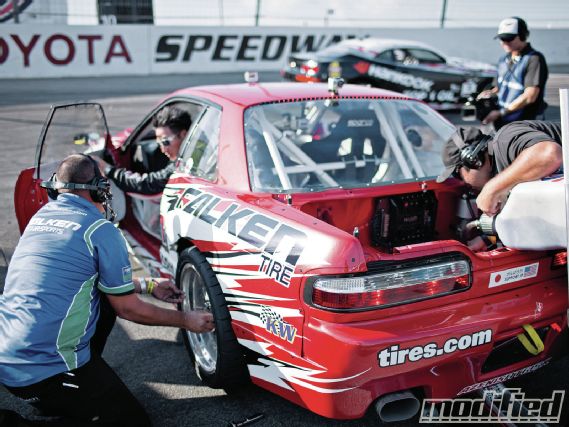 |
Track-side toe measurement with Longacre toe plates. While a setup pad is ideal, a flat piece of concrete can do the job. Have a helper hold the plate on the opposing side while you measure with two identical tape measurers. Make sure lettering or high spots on the tire aren’t giving you false readings.
|
Track-side toe measurement with Longacre toe plates. While a setup pad is ideal, a flat piece of concrete can do the job. Have a helper hold the plate on the opposing side while you measure with two identical tape measurers. Make sure lettering or high spots on the tire aren’t giving you false readings.
The above modifications will add up to give you a complete track-ready suspension package that will make your car more fun and predictable to drive on track. There will be compromises if you’re street driving the car, but chances are if you’re serious about going fast, you’re more than willing to make those concessions.
